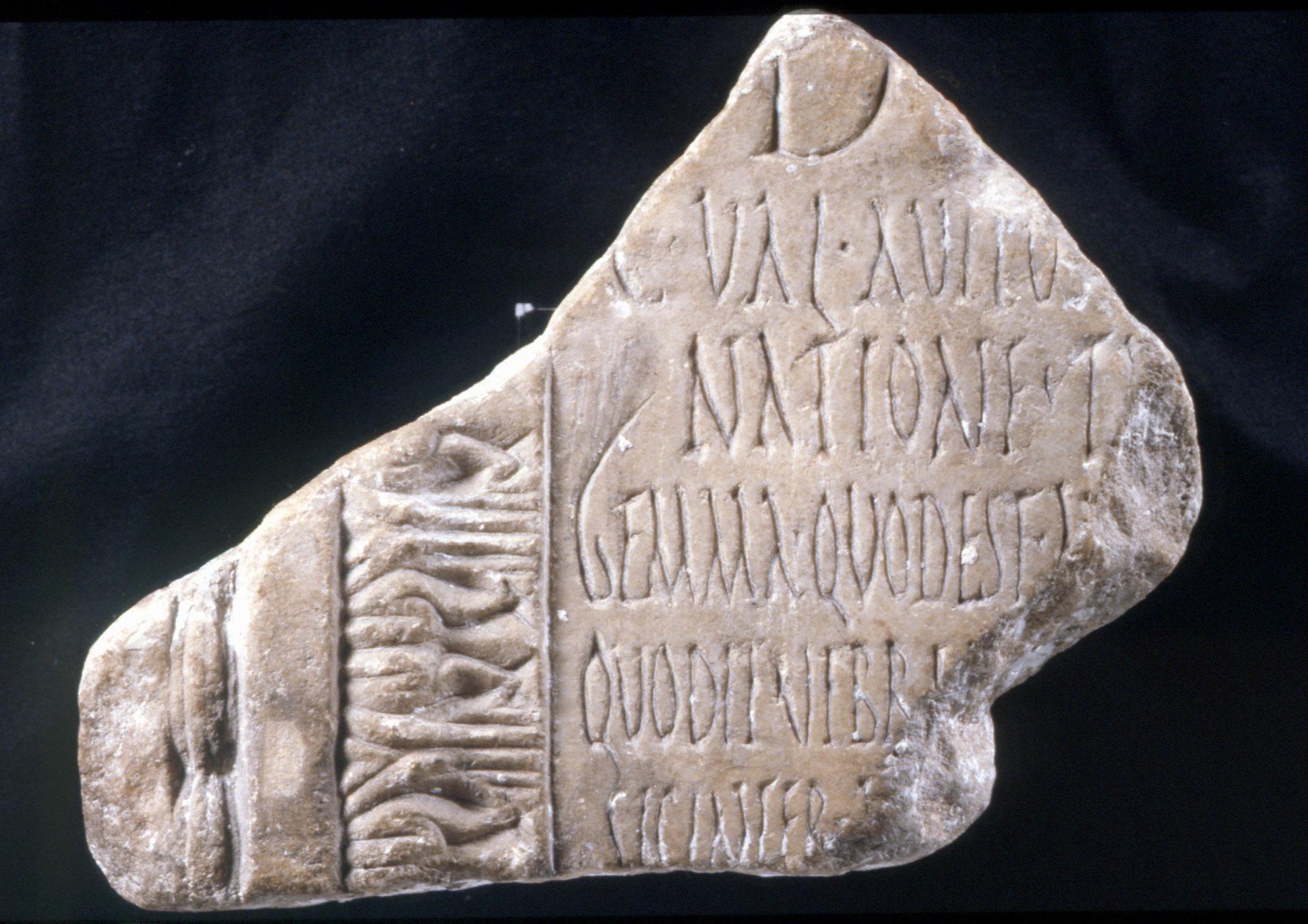CO6 Epitafio de Gayo Valerio Avito
Referencia CIL II 2253 = II2 / 7,394 | Descripción | Letra | Localización | Cronología | Edición epigráfica | Traducción | Aparato crítico | Comentario | Tipo de verso | Texto dividido en versos y signos métricos | Imágenes | Bibliografía | Enlace a BBDD | Nombre de autor/autores |
CO6 Epitafio de Gayo Valerio Avito
Descripción
- Idno filename 22/01/0083
- Tipo de inscripción: Sepulcralis
- Descripción del material: White colour
- Descripción del estado de conservación: Fragmented at the left-hand part of the inscription
- Medidas alto/ancho/fondo (cm): 20.5/27/6
-
Campo epigráfico:
- Disposición del texto en el soporte: Good "ordinatio". Triangular interpunctions (l. 2, dots) except after quod l. 4 and sic, l. 6.
- Dimensiones del campo epigráfico alto/ancho (cm): 20.5/14
- Descripción de la decoración: The writing field is delimited by a frieze with a border, fillet and broader band with plant decoration which "does not adopt any of the forms known in the repertoire of Roman repertoire of Roman architectural decoration of the first two centuries of our era: the leaves take on an almost abstract form, which is leaves take on an almost abstract form, which is highly improbable, not to say unthinkable, at a time when all the repertoires were perfectly systematised. at a time when all the repertoires were perfectly systematised."
- Conservada
Letra
- Tipo de letras:Libraria
- Medidas de las letras:1, letters of 3,7; rest, 2/3; l. 4, G summa, 5 cm
- Descripción de las letras:Left-hand shaft of <N> truncated.
Localización
- Lugar de hallazgo: Found in 1758 in Córdoba, "in the houses bordering Santa Marina cemetery" AYORA and RUANO apud STYLOW.
- Geolocalizacion
- Lugar de conservación: It was moved to the Huerta de los Aldabones, in Costanilla de San Lorenzo, where it was seen by PÉREZ BAYER and, in 1861, by HÜBNER L. MARAVER and ALFARO donated it to the M.A.N. in Madrid.
- Número de inventario: 16834
- Ubicación con NOMENCLATURA MODERNA con ESCALA MACRO España / Córdoba
- Ubicación con NOMENCLATURA ANTIGUA con ESCALA MACRO Hispania / Baetica / Cordubensis / Corduba
Cronología
- Datación de la inscripción: Entre el año 200 y el año 299
- Justificación de la datación: In view of the paleography and the onomastic system, Stylow dated it to the end of the 2nd c. or beginning of the 3rd c. For the reasons mentioned above (type of moulding, metaphorical use of gemma), it is more likely to be 3rd c.
Tipo de verso
- Tipo de verso: Dactílico (hexámetro)
- Corresp. verso/línea: Si
- Distinc. prosa/verso: Si
Edición epigráfica
D(is) [M(anibus) s(acrum)]
C(aius)▴ Val(erius) ▴ Avitus [‑ ‑ ‑]
natione ▴ T+[‑ ‑ ‑]
gemma ▴ quod est ▴ m[‑ ‑ ‑]
5 quod tenebrị [‑ ‑ ‑]
sic inter ▴ +[‑ ‑ ‑]
‑ ‑ ‑ ‑ ‑ ‑
Texto dividido en versos y signos métricos
gemma quod est m[- – -] lkk|l/[n|ln|ln|lkk|l~]
quod tenebri [- – -] lkk|x[n|ln|ln|lkk|l~] or lkk|x[n|lUlkk|lkk|~]
sic inter [- – -] ll|x[n|ln|ln|lkk|l~]
– – – – – –
Traducción
(Consecrated) to the gods (the Manes). Gaius Valerius Avitus, by birth[ ] Because he is the jewel[ ],because from the darkness[ ], thus among[ ]
Bibliografía
M. J. de Ayora y Pinedo in epistula data ad López Cárdenas, quam Hübnner vidit solutam inter eius ms. 1765, et in Vázquez Venegas, ms. saec. XVIII, XII; Ruano 1762, I 183; Pérez Bayer, ms. 1782, 25 r.; Hübner 1860/61, 59–60 et II 2253 (Maraver 1863, 324 n. 83; de la Rada 1876, 273, del Rivero 1933, 55 n. 199); Haley 1986, 16 adn. 11, 104 n. 8 ex schedis Stylow (HEp 1993, 163); Stylow, II2/7, 394, cum im. phot., Fernández Martínez – Carande, CLEB, CO4, cum im. phot.; Cugusi 2012, n. 28. – Cf. Albertini 1912b, 309.
Aparato crítico
Litt. N to sinistra truncata v. 5.
3 natione · i Pérez Bayer, natione · ta Stylow. – 4 Cemna Hübner; quod est·A Stylow. – 5 quo die · febru Hübner, quod te(n)ebr++ Stylow. – 6 sis · inter · k Hübner, de la Rada, del Rivero.
Comentario
Carmen preceded by a praescriptum in prose (ll. 1-3). The beginnings of three verses,
dactylic hexameters or distichs, are conserved. Line 3 mentions the origin of the deceased, after
which is preserved a <T> and the remains of a second letter that Stylow identifies as an <A>,
proposing, along with Haley, the Lusitanian populus, Ta[porus]. However, it seems almost
certain that it is an <H>, in which case it is possible to infer a Thrax or Thracius (cf. Stylow
II2/7,24 natione Thracie); the concept of natio is usually broader, cf. Cagnat 1890, 63. Its
fragmentary condition makes interpretation difficult. In l. 4, Gemma could have a metaphorical
sense, as is usual in Christian poets and inscriptions, cf. CLE 1560B,3 and 688,8 (449 AD). L. 5
must refer to the darkness of death (cf. CLE 2131,3 and 503,2).
Nombre de autor/autores
- Nombre de autor/autores:R. Carande Herrero, C. Fernández Martínez
- Última modificación2024-01-31 16:45:33
- Fecha de autopsia:2001
Puedes descargar esta





